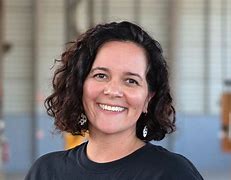POSTED: 15 Jun, 2022

The Australian Cobotics Centre has some incredibly E.P.I.C. researchers. Each month we will be profiling a different researcher. Associate Professor Glenda Caldwell, co-Lead of the ‘Designing Socio-Technical Robotics Systems‘ program and the Centre’s Open Innovation Network, is kicking things off.
We sat down with Glenda recently to find out more about why she does what she does.
-
Tell us a bit about yourself and your research with the Centre?
My disciplinary background is in Architecture with a particular interest in computational design and digital fabrication. I have always been fascinated – a little intimidated and inspired – by technology (software and hardware) and its impact on how we make things, how it impacts our design processes, and our ability to visualise and communicate our ideas. The research we are doing in Program 3: Designing Socio-Technical Robotic Systems looks to explore and further understand what and how human centered design methods and processes can facilitate or drive the integration, implementation and adoption of Collaborative Robots into manufacturing tasks of industry partners. We explore the human factors such as ergonomics and motivation, the design factors such as use of space, design of systems and robotic tools, and the virtual factors such as use of VR to simulate and validate cobotic tasks in safe virtual environments. We intend to use design approaches to take the people on the workshop floor on the journey with us of exploring how and why a cobot can improve the manufacturing tasks they are working on. The outcomes we seek will deliver safer working environments that are more productive and efficient while more importantly will also be more enjoyable and stimulating for humans working collaboratively with robots.
-
Why did you decide to be a part of the Australian Cobotics Centre?
I see being a part of the Australian Cobotics Centre as a natural next step and evolution from the completed IMCRC Design Robotics Project where I was a Chief Investigator. There were many research opportunities that arose from that project where we could see the tremendous value for further Cobotics research in manufacturing. The ACC provides opportunities to work with researchers from a range of disciplines and backgrounds from UTS, Swinburne and QUT while collaborating with diverse industry partners who create different types of products using different manufacturing processes and materials. This mixture and breadth of expertise from both the academics and the industry sides is super exciting and essential to collaborate on and address the different challenges and many opportunities for cobotic solutions. This is an ideal test bed for progressing impactful design and cobotic research which is emerging in recognition not only in manufacturing but in other sectors such as construction and for helping to develop the next research superstars who are embarking on their own research and career journeys.
-
What project are you most proud of throughout your career and why?
During my PhD I was able to secure internal seed funding for a project called the InstaBooth, a purpose designed and built pop-up interactive booth for community engagement. Its purpose was to include and capture the voices of people from public places and assist in their communication and envisioning of the city they wanted to live in. This tiny, but quick to grow large, project was highly collaborative with colleagues from across disciplines, with other PhD students, undergraduate students, other universities including California Polytechnic University and University of Sydney, and numerous community partners. The project was creative, collaborative, and so much fun while also highly impactful not only for the researchers and students involved but also for the community members who participated and engaged with it. I am most proud of this project.
-
What do you hope the long-term impact of your work will be?
My ambition and long -term impact of my work will not only be for the successful design of the integration of cobots into our industry partners’ manufacturing lines but also more broadly to the manufacturing and construction industry demonstrating that human centered design is essential in creating workspaces, places, and processes that respond to the needs of humans while being safe, efficient, and sustainable. I am driven by openness, collaboration and creativity for innovative outcomes and hope that these key ingredients will help to create environments that support gender equity in research and climate responsible processes and solutions.
-
Aside from your research, what topic could you give an hour-long presentation on with little to no preparation?
I could talk about teaching in Architecture or Research Methods. I could talk broadly about Computational Architecture and Design Robotics. My other research topics – Media Architecture (can put together quickly) or Human Building Interaction (would need time to put this together though) is something I could also talk about. I could also talk about being an academic and a mum, and the juggle of work life balance : )
Glenda also works with the QUT Design Lab. Read more about one of Glenda’s recent projects which was a collaboration between QUT, Griffith University, The University of Melbourne, La Trobe University, and Monash University: Transforming Aged Care with Virtual Reality.
Recent News
Celebrating the Robotics & Advanced Manufacturing Centre at TAFE Queensland!
On 17th June 2025, our Centre was part of the official opening of the Robotics and Advanced Manufacturing Centre (RAMC) at TAFE Queensland Eagle Farm ...
Meet our E.P.I.C. Researcher, Sheila Sutjipto
Sheila Sutjipto is a Postdoctoral Research Fellow in the Biomimic Program where her research explores physical human–robot interaction (pHRI). She ...
Fireside Chat Series Continues with B&R Enclosures
The Australian Cobotics Centre is thrilled to continue its Fireside Chat series with B&R Enclosures, one of our valued industry partners. These i ...